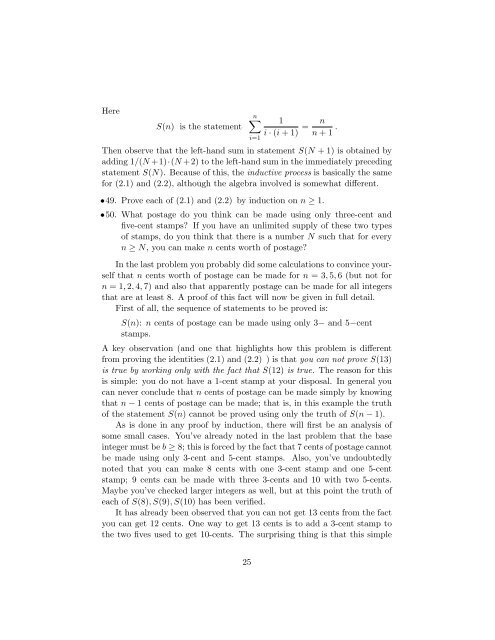DISCRETE MATHEMATICS THROUGH GUIDED DISCOVERY ...
DISCRETE MATHEMATICS THROUGH GUIDED DISCOVERY ...
DISCRETE MATHEMATICS THROUGH GUIDED DISCOVERY ...
You also want an ePaper? Increase the reach of your titles
YUMPU automatically turns print PDFs into web optimized ePapers that Google loves.
Here<br />
S(n) is the statement<br />
n�<br />
i=1<br />
1 n<br />
=<br />
i · (i + 1) n + 1 .<br />
Then observe that the left-hand sum in statement S(N + 1) is obtained by<br />
adding 1/(N +1)·(N +2) to the left-hand sum in the immediately preceding<br />
statement S(N). Because of this, the inductive process is basically the same<br />
for (2.1) and (2.2), although the algebra involved is somewhat different.<br />
•49. Prove each of (2.1) and (2.2) by induction on n ≥ 1.<br />
•50. What postage do you think can be made using only three-cent and<br />
five-cent stamps? If you have an unlimited supply of these two types<br />
of stamps, do you think that there is a number N such that for every<br />
n ≥ N, you can make n cents worth of postage?<br />
In the last problem you probably did some calculations to convince yourself<br />
that n cents worth of postage can be made for n = 3, 5, 6 (but not for<br />
n = 1, 2, 4, 7) and also that apparently postage can be made for all integers<br />
that are at least 8. A proof of this fact will now be given in full detail.<br />
First of all, the sequence of statements to be proved is:<br />
S(n): n cents of postage can be made using only 3− and 5−cent<br />
stamps.<br />
A key observation (and one that highlights how this problem is different<br />
from proving the identities (2.1) and (2.2) ) is that you can not prove S(13)<br />
is true by working only with the fact that S(12) is true. The reason for this<br />
is simple: you do not have a 1-cent stamp at your disposal. In general you<br />
can never conclude that n cents of postage can be made simply by knowing<br />
that n − 1 cents of postage can be made; that is, in this example the truth<br />
of the statement S(n) cannot be proved using only the truth of S(n − 1).<br />
As is done in any proof by induction, there will first be an analysis of<br />
some small cases. You’ve already noted in the last problem that the base<br />
integer must be b ≥ 8; this is forced by the fact that 7 cents of postage cannot<br />
be made using only 3-cent and 5-cent stamps. Also, you’ve undoubtedly<br />
noted that you can make 8 cents with one 3-cent stamp and one 5-cent<br />
stamp; 9 cents can be made with three 3-cents and 10 with two 5-cents.<br />
Maybe you’ve checked larger integers as well, but at this point the truth of<br />
each of S(8), S(9), S(10) has been verified.<br />
It has already been observed that you can not get 13 cents from the fact<br />
you can get 12 cents. One way to get 13 cents is to add a 3-cent stamp to<br />
the two fives used to get 10-cents. The surprising thing is that this simple<br />
25

















